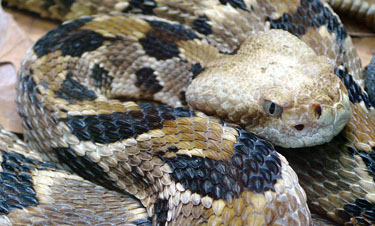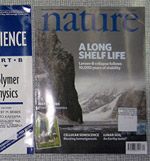Snakes interrupted: roads causing genetic decline
 Evolutionary Bio,
Evolutionary Bio,  Herps
Herps  Timber rattlesnake (Crotalus horridus). Image credit, Tim Vickers For wildlife like the timber rattlesnsake, trying to cross even light-traffic country roads presents a formidable life-or-death challenge. As a new study in the journal Conservation Biology shows, these roads can also contribute to the genetic decline of the species.
Timber rattlesnake (Crotalus horridus). Image credit, Tim Vickers For wildlife like the timber rattlesnsake, trying to cross even light-traffic country roads presents a formidable life-or-death challenge. As a new study in the journal Conservation Biology shows, these roads can also contribute to the genetic decline of the species.
This can occur when roads cut off the path of movement of individuals leading to isolated groups that are unable to reproduce together. This in turn causes a reduction in genetic flow across the population.
To examine this issue in the timber rattlesnake, Rulon Clark and fellow researchers conducted genetic sampling of individuals within two types of forested areas in upstate New York - one fragmented by several low-traffic roads and the other road-free.
They found that genetic diversity was lower in the areas with roads - likely because reproduction had been occurring among smaller pools of individuals. Further, snakes in areas with roads had undergone greater extent of genetic differentiation indicating a reduction in gene flow as isolated groups of snakes went down their own distinct trajectories of genetic change.
These findings bode ill for the snake and other wildlife undergoing a similar phenomenon. High genetic diversity and flow are important for maintaining healthy populations capable of adapting to environmental stressors.
The study provides evidence that roads are at least partly to blame. The researchers conducted a landscape genetic analysis to compare where pairings between snakes would occur in the absence of disturbance versus what was actually recorded. They found that roads acted as major barrier to genetic connectivity.
This makes sense for the timber rattlesnake based on past behavioral studies. The authors write,
"In an experimental study, Andrews and Gibbons (2005) demonstrated that timber rattlesnakes cross roads slowly (approximately 10 cm/s) and individuals stop moving and remain immobile for up to a minute or more in response to any traffic noise. From their behavioral data, they estimated that timber rattlesnakes crossing roads would suffer an 80% mortality rate on roads with a traffic volume of 3,000 cars/day, a traffic level corresponding to the minor roads in our study."
This high mortality level, along with plain avoidance of roads, likely plays a key role in the observed genetic decline. Given the findings, the authors recommend that measures such as the construction of culverts be undertaken to minimize the impacts to the snakes. They note however that more research is needed to determine whether these measurers will actually have a beneficial effect on restoring genetic connectivity.
--Reviewed by Rob Goldstein
CLARK, R., BROWN, W., STECHERT, R., & ZAMUDIO, K. (2010). Roads, Interrupted Dispersal, and Genetic Diversity in Timber Rattlesnakes Conservation Biology DOI: 10.1111/j.1523-1739.2009.01439.x




Reader Comments